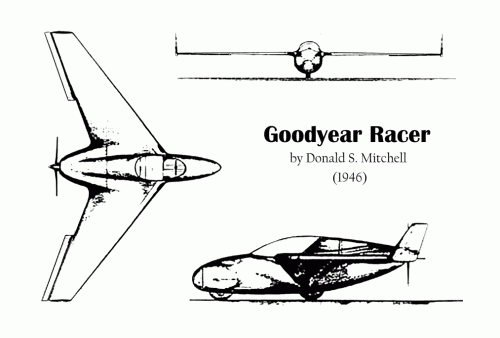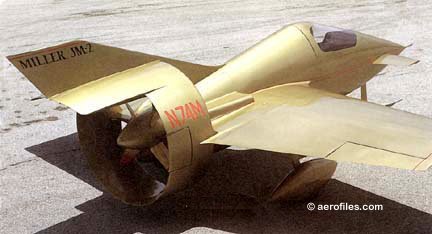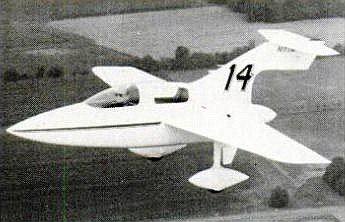- Joined
- 25 June 2009
- Messages
- 14,758
- Reaction score
- 6,163
Excerpts from a 1946 brochure whereby glider designer Don Mitchell hoped to raise an interest and attract some financing for a revolutionary flying wing racer design to be submitted to the “Goodyear Trophy Race” competition.
Mitchell is especially known for his work with Hawley Bowlus on the Bumble Bee/Dragonfly design, his Nimbus gliders of the 1950s and his Mitchell Wing (B-10, A-10) powered hang gliders and Super Wing (U-2) ultralight powered glider.

The National Air Races held annually at Cleveland, Ohio are a thrilling air show a valuable source of aircraft improvement.
In 1946, to encourage the design and development of light aircraft the Goodyear Tire & Rubber Company created and sponsored the “Goodyear Trophy Race” as part of the National Air Races.
This booklet is submitted in a sincere effort to obtain a sponsor and co-owner for the racer herein described. It is a project that vigorously breaks away from the exhausted conventional design.
It is not, however, a flight of the imagination, but rather one based on sound advanced aerodynamics with practical data proving this type of aircraft is without parallel.
It is a project that not only will admirably perform its main purpose of winning races, but one that can be used as a nucleus for the design of cheap, safe, high performance light aircraft, military pilotless jet drones, target ships, and practical roadable airplanes.
The reader will recognize within these covers the outline of a project that will have an immediate satisfaction and profit to the sponsor, designer, and to the aircraft industry as a whole.
Donald S. Mitchell
WHY THIS RACER?
Because,
. . . It is ultra modern and sensational in appearance;
. . . It has sparkling, exciting performance; it has the ability to smash records;
. . . It has eye appeal and fires the imagin-ation - qualities necessary for wide-spread and
lasting publicity;
. . . It has the “New Look” in aviation;
. . . It has terrific potentialities besides racing;
. . . It will be the first flying wing to compete in the National Air Races;
. . . It has a basic control method destined to bring a new era to aviation.
Winning races is the prime purpose of a racing airplane. THIS flying wing will do that -- and much more.
SPECIFICATIONS Top Speed 245 M.P.H.
Landing Speed 55 M.P.H.
Engine Continental C-85
85 H.P. at 2570 R.P.M.
Pusher Installation
Span 18 feet
Area 72 Sq. Feet
Sweepback 40 Degrees
Total length 9 Feet
Nacelle height 43 Inches
Weight empty 400 lbs. **
Ballast 100 lbs. **
Landing Gear Tandem (Two Goodyear tires and wheels- 5.00-5)
Brake on rear wheel
No dihedral. No wing twist.
** 500 lbs. minimum weight empty required for Goodyear Race.
For the full contents of the brochure, see this page:
http://www.twitt.org/GoodyearRacer.html
Mitchell is especially known for his work with Hawley Bowlus on the Bumble Bee/Dragonfly design, his Nimbus gliders of the 1950s and his Mitchell Wing (B-10, A-10) powered hang gliders and Super Wing (U-2) ultralight powered glider.
The National Air Races held annually at Cleveland, Ohio are a thrilling air show a valuable source of aircraft improvement.
In 1946, to encourage the design and development of light aircraft the Goodyear Tire & Rubber Company created and sponsored the “Goodyear Trophy Race” as part of the National Air Races.
This booklet is submitted in a sincere effort to obtain a sponsor and co-owner for the racer herein described. It is a project that vigorously breaks away from the exhausted conventional design.
It is not, however, a flight of the imagination, but rather one based on sound advanced aerodynamics with practical data proving this type of aircraft is without parallel.
It is a project that not only will admirably perform its main purpose of winning races, but one that can be used as a nucleus for the design of cheap, safe, high performance light aircraft, military pilotless jet drones, target ships, and practical roadable airplanes.
The reader will recognize within these covers the outline of a project that will have an immediate satisfaction and profit to the sponsor, designer, and to the aircraft industry as a whole.
Donald S. Mitchell
WHY THIS RACER?
Because,
. . . It is ultra modern and sensational in appearance;
. . . It has sparkling, exciting performance; it has the ability to smash records;
. . . It has eye appeal and fires the imagin-ation - qualities necessary for wide-spread and
lasting publicity;
. . . It has the “New Look” in aviation;
. . . It has terrific potentialities besides racing;
. . . It will be the first flying wing to compete in the National Air Races;
. . . It has a basic control method destined to bring a new era to aviation.
Winning races is the prime purpose of a racing airplane. THIS flying wing will do that -- and much more.
SPECIFICATIONS Top Speed 245 M.P.H.
Landing Speed 55 M.P.H.
Engine Continental C-85
85 H.P. at 2570 R.P.M.
Pusher Installation
Span 18 feet
Area 72 Sq. Feet
Sweepback 40 Degrees
Total length 9 Feet
Nacelle height 43 Inches
Weight empty 400 lbs. **
Ballast 100 lbs. **
Landing Gear Tandem (Two Goodyear tires and wheels- 5.00-5)
Brake on rear wheel
No dihedral. No wing twist.
** 500 lbs. minimum weight empty required for Goodyear Race.
For the full contents of the brochure, see this page:
http://www.twitt.org/GoodyearRacer.html



